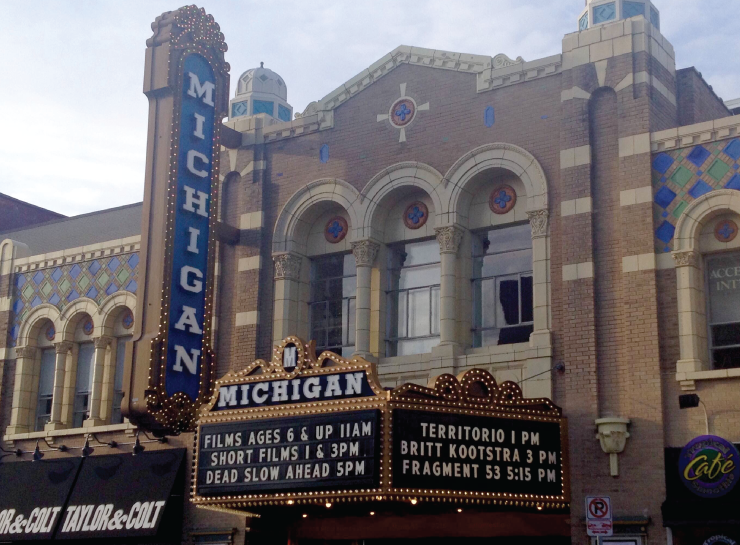Movie Marathon: My 48 Hours at the Ann Arbor Film Festival

The Ann Arbor Film Festival offers a true marathon of screenings and events, with over 200 individual films screening over the course of just six days. This is not including the satellite events, such as off-site gallery shows hosted by the Work Gallery and Ann Arbor Art Center, various store front installations, panel discussions, workshops, and crowded after-parties hosted by local bars. It is, put simply, A LOT to see. It is also by design, simply too much to see, with many events happening concurrently between the Michigan Theater’s main auditorium and screening room.
I wanted to see it all.
So I designed and accepted this challenge for myself whole-heartedly, with nothing to lose, except perhaps sleep and daily exposure to vitamin D; I committed myself to spending two entire days at the festival. I wanted to watch every scheduled film possible, to experience the festival lifestyle, and to test my own endurance. I was not alone in this challenge--many other audience members became familiar faces and some of them became friends. There were audience members, including local Ann Arborites and those who travel annually to Ann Arbor solely to see the festival, all whom camped out in the theater for the entire six days. I couldn’t possibly compete with that.
But over the course of 48 hours, beginning promptly at 7:15 pm Thursday evening and concluding at who-knows-when Saturday night, I viewed over 50 short and feature-length films. Fifty! More importantly, I experienced what truly makes the Ann Arbor Film Festival special: its spirit, its devoted community, and its sense of collective experience.
My personal challenge began with Thursday evening’s Films in Competition 3 program. It was a beautifully curated program, combining short films by different makers that explored different facets of landscape. Nicky Hamlyn’s Gasometers 3 offered a series of time-lapses, painstakingly made with a 16mm film camera. The stunning time-lapses highlighted the movement of the sky, as clouds and sunlight shifted around sturdy metal gasometer structures that stood still, revealing time passing. The film was silent. And in a theatre packed with people, restless legs, squeaking seats, and small coughs interrupted the silence, which was admittedly frustrating at first. Until I considered how amazing it is, and how rare it must be, for an audience to fill a theater and watch a silent 16mm film.
On Friday, I was excited for the screening of Chantal Akerman’s D’est (From the East).The festival screened three of Akerman’s feature films, celebrating and honoring her career, after she passed away in 2015. Considered a “cinematic elegy,” this 1993 film depicts the filmmaker’s travels beginning in East Germany towards Moscow as the warmer seasons transition to winter. The film was presented in its original 16mm format. The shots are long and revealing, often beginning without action. One shot opens on an empty sidewalk; an older woman wearing a brown dress walks into the frame. The camera follows as the woman shuffles onward, swinging a red plastic bag at her side. Seemingly minute, the small action gains meaning as it continues. The 16mm film print was a bit wobbly on screen. It bounced unsteadily until one staggering moment in which it stopped. A section of film caught in the gate of the projector and burned, visibly onscreen, to an audible and collective gasp. The image bubbled, turning murky brown, and then evaporated entirely. The projector was turned off; the room went dark.
The sense of loss was palpable. People whispered in the dark, pulled out their cell phones, and waited. It was later determined the film print was too damaged to continue (but only after a second, gut-wrenching burn). This event, this shared experience of both pleasure and loss, overshadowed the day’s later screenings. It was a singular experience, one that brought strangers together, perhaps more so than the film itself.
On Saturday morning I returned to the theater only slightly sleepy-eyed for the 11 am Films in Competition 5 (Ages 6+). The theater was starting to feel more like home than my real home. Having become so comfortable there, I could feel a change in the space - the theater was stirring. The audience included many children. They ate popcorn and kicked their small feet in anticipation for the films to start. The program included Standish Lawder’s Catfilm for Katy and Cynnie. In one section, the screen was just a wash of white. There was a vague image, but it didn’t look like anything at all. I worried that it wasn’t captivating enough for the young audience. I looked around to gauge their interest. I looked back at the screen, and slowly, the white started to move. Collectively, we realized we were watching cat tongues lapping at milk, and that our perspective was from underneath the bowl. Pink cat tongues and noses pushed milk around the glass surface and children squealed. It was delightful, funny, not unlike the joy of an Internet video, except that we were all experiencing it together, at the same time.
My 48 hours at the Ann Arbor Film Festival showed me that the movie theater is still a magical place. I saw films that made me laugh, moved me, and tested my patience. I saw films with many strangers. I ate popcorn for dinner two nights in a row. And I decided that next year, I would like to do it all again.
Elizabeth Wodzinski is a Desk Clerk at the Ann Arbor District Library and she wishes that Catfilm were available on YouTube so she could watch it over and over.


































